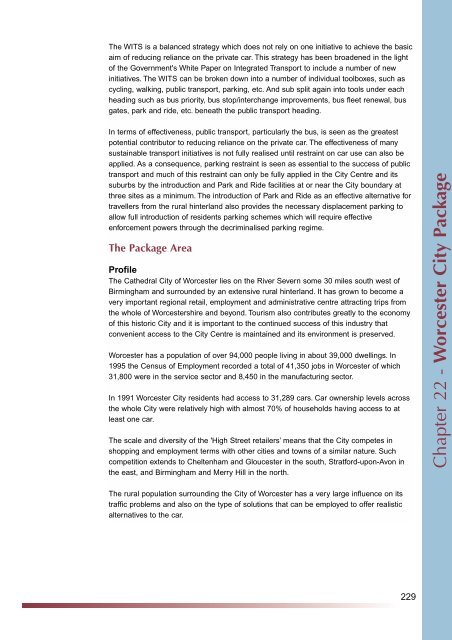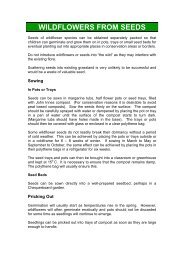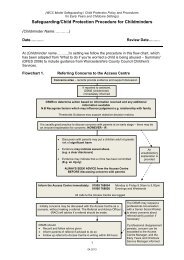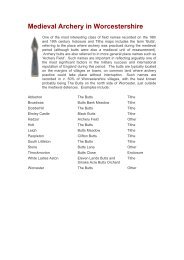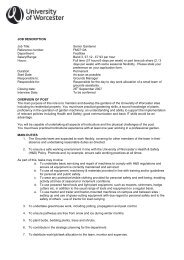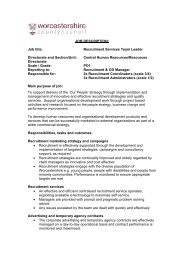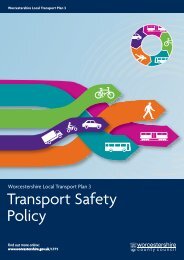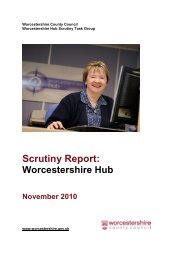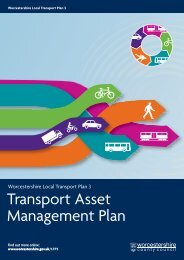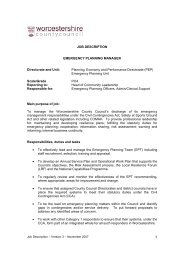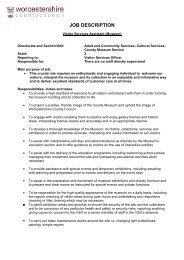Integrated Public Transport Strategy - Worcestershire County Council
Integrated Public Transport Strategy - Worcestershire County Council
Integrated Public Transport Strategy - Worcestershire County Council
You also want an ePaper? Increase the reach of your titles
YUMPU automatically turns print PDFs into web optimized ePapers that Google loves.
The WITS is a balanced strategy which does not rely on one initiative to achieve the basic<br />
aim of reducing reliance on the private car. This strategy has been broadened in the light<br />
of the Government's White Paper on <strong>Integrated</strong> <strong>Transport</strong> to include a number of new<br />
initiatives. The WITS can be broken down into a number of individual toolboxes, such as<br />
cycling, walking, public transport, parking, etc. And sub split again into tools under each<br />
heading such as bus priority, bus stop/interchange improvements, bus fleet renewal, bus<br />
gates, park and ride, etc. beneath the public transport heading.<br />
In terms of effectiveness, public transport, particularly the bus, is seen as the greatest<br />
potential contributor to reducing reliance on the private car. The effectiveness of many<br />
sustainable transport initiatives is not fully realised until restraint on car use can also be<br />
applied. As a consequence, parking restraint is seen as essential to the success of public<br />
transport and much of this restraint can only be fully applied in the City Centre and its<br />
suburbs by the introduction and Park and Ride facilities at or near the City boundary at<br />
three sites as a minimum. The introduction of Park and Ride as an effective alternative for<br />
travellers from the rural hinterland also provides the necessary displacement parking to<br />
allow full introduction of residents parking schemes which will require effective<br />
enforcement powers through the decriminalised parking regime.<br />
The Package Area<br />
Profile<br />
The Cathedral City of Worcester lies on the River Severn some 30 miles south west of<br />
Birmingham and surrounded by an extensive rural hinterland. It has grown to become a<br />
very important regional retail, employment and administrative centre attracting trips from<br />
the whole of <strong>Worcestershire</strong> and beyond. Tourism also contributes greatly to the economy<br />
of this historic City and it is important to the continued success of this industry that<br />
convenient access to the City Centre is maintained and its environment is preserved.<br />
Worcester has a population of over 94,000 people living in about 39,000 dwellings. In<br />
1995 the Census of Employment recorded a total of 41,350 jobs in Worcester of which<br />
31,800 were in the service sector and 8,450 in the manufacturing sector.<br />
In 1991 Worcester City residents had access to 31,289 cars. Car ownership levels across<br />
the whole City were relatively high with almost 70% of households having access to at<br />
least one car.<br />
The scale and diversity of the 'High Street retailers’ means that the City competes in<br />
shopping and employment terms with other cities and towns of a similar nature. Such<br />
competition extends to Cheltenham and Gloucester in the south, Stratford-upon-Avon in<br />
the east, and Birmingham and Merry Hill in the north.<br />
The rural population surrounding the City of Worcester has a very large influence on its<br />
traffic problems and also on the type of solutions that can be employed to offer realistic<br />
alternatives to the car.<br />
229<br />
Chapter 22 - Worcester City Package


